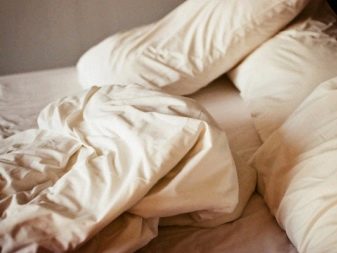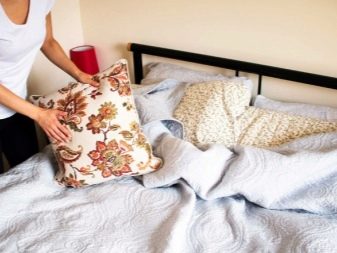How often should bed linen be changed?

Bed linen needs to be changed regularly. This is a must-have procedure that will help make your sleep comfortable and will have a beneficial effect on your health. If you neglect this, then there is a risk of problems, and very serious ones. About what a rare change of bed linen is fraught with, how often it needs to be changed and more, read below.



Why is it necessary to change?
Bed linen at home needs to be updated frequently, at least for hygiene reasons. Few people will enjoy sleeping on bedding that has an unpleasant odor of sweat or something else. In addition, bed linen tends to get dirty quickly, after just one night, skin particles, natural fatty oils, dandruff, sebum, street dirt, food crumbs, as well as saliva, sweat, and some also have pet hair remain on it. , the remains of cosmetics. It is these conditions that are favorable for the emergence and spread of a whole "botanical garden": dust mites, viruses, bacteria, mold and fungal spores, as well as various skin diseases. Harmful microorganisms and parasitic insects multiply at times more actively if there is a large number of crumbs and animal hair on the bed. These pests pose a huge threat to people who neglect to regularly change bedding.
From this list, the most dangerous for humans and their health are dust mites, namely their excrement. This is due to their toxicity.Due to the secretions of a tick, a person may experience a weakening of the immune system, a serious allergic reaction, especially for those people who have certain problems with the respiratory system.
Moreover, the secretions of a dust mite have a negative effect on the human skin, destroying them, which entails the occurrence of skin problems: it becomes more vulnerable, acne and various rashes begin to appear, dermatitis and even ulcers may begin to develop.


In asthmatics, dust mites can have a dramatic increase in attacks. In addition, people in whose bed harmful insects have started can develop conjunctivitis, allergies, an increased tendency to certain infections, cough, rhinitis, dermatitis, and Quincke's edema. And if the tick enters the human gastrointestinal tract, then there is a high risk of developing deep acariasis.
Besides, bed linen is recommended to be changed often for those people who are characterized by strong perspiration, dust allergy.
A clean and fresh bed is a guarantee of good and quality sleep, and therefore you should not neglect the regular change of bed linen if your sound sleep and health are dear to you.


How many times do you need to change the bedding in a month?
Some people mistakenly think that if they sleep on the bed alone, then in this case, the bed linen on it can be changed several times less often. However, this opinion is erroneous. Bed linen should be changed as often as possible. In any case, this should be done at least once a week or 10 days, that is, about three to four times a month. If you are allergic to dust, asthma, or if you like to sleep in or eat in a bed with your pet, then it is recommended to change bed linen more often. This should also include factors such as sleeping naked, sleeping several people on the same bedding and physiological characteristics (such as profuse sweating).
Besides, change of bed linen depends on its configuration. So, according to the recommendation of experts, it is recommended to change the one-and-a-half set at intervals of 2 weeks in cold seasons and more often in summer, since it is at this time that a person sweats profusely and, in addition, walks in open clothes (a larger amount of all kinds of dirt settles on his skin and dust). In the summertime, it is recommended to change the bed every few days. A double bedding set needs to be changed at intervals of a week and more often - again, depending on the time of year.



The duvet cover can be washed a little less often - about once every 10-15 days. The same goes for a simple comforter that is used without a duvet cover. Do not forget about the mattress topper, which, like other elements of bedding, requires periodic washing - it must be washed once a month, this will be enough.
It is also worth mentioning pillows and mattresses. They also need to be cleaned periodically, although not as often as duvet covers, sheets, and pillowcases.
It is recommended to regularly clean the mattress with a vacuum cleaner or steam it, and whip and freshen the pillows - this will not only make your sleep more comfortable, but will also help to extend the life of the pillow.


Features of replacement for people of different ages
For adults
The frequency of changing bed linen for an adult depends on what material the linen is made of. So, if it is made of natural fabrics, then you can change it once every 7 days, if there are no unforeseen circumstances and the linen is not smeared into something. In the presence of diseases, open injuries, infections, skin problems, bed linen will have to be changed a little more often.
Synthetics will have to be changed daily in any case.



For newborns
Small children spend a huge amount of time in cribs, and the bed linen gets dirty several times more actively: drooling, feces ... Baby bedding will need to be changed frequently. Babies change their beds every day, and sometimes more often, depending on the pollution. Infants' bedding should be changed every 2-3 days (again, depending on how quickly it gets dirty).
If your child sleeps on a pillow, it is also recommended to wash it at least once a week, just like the blanket.
After washing, the bed linen of small children must be ironed.


For children from 2 years old
Young children from 2 years old often eat or play in bed. In addition, due to their high activity, they tend to get dirty often. Because of this, their sheets must be shaken out before going to bed in order to get rid of possible remnants of food, toys and other objects. Change of bed linen is carried out depending on the age of the child.
So, if he is under 5 years old, then the bed should be changed at intervals of 3-4 days. For older children, bedding can be changed once a week.
If we talk about kindergartens, then there bed linen from children's beds is changed strictly every week, as well as in some cases and more often if it gets dirty for one reason or another.


For teenagers
For adolescents, due to the physiological characteristics of the body, it is recommended to update the bed linen as often as possible, again for hygienic reasons. This is due to the fact that the human body during this period is characterized by especially strong sweating, and other adolescent "joys".
So, it is recommended to change the teen's sheet and duvet cover every 4 days.

Frequency of linen change for allergy sufferers
People with dust allergies will need to change their pillowcases daily, and sheets and duvet covers every 5 days. You need to do this for your own comfort and good sleep. In addition, it is recommended that blankets and pillows are ventilated on an ongoing basis, as well as regular cleaning of the mattress with a vacuum cleaner.
If a person's allergy is not caused by dust, then it is recommended to change bed linen at least once every 5-7 days.


Interesting Facts
Regular bed linen change is a routine for many, which is generally carried out stably once a week, or even more often. It is interesting that in European countries everything happens a little differently. So, it was precisely established that in the same England bed linen is washed much less often than in our country.
It is estimated that 35% of British people wash their clothes every 2 weeks, 20% do it every month, and another 10% change bedding less than once a month. It turned out that about half a million housewives wash their bedding once a year! For this reason, most Europeans choose long-sleeved, closed pajamas for sleeping. In light nightgowns or without clothes at all, they rarely sleep.
The reason for this behavior is banal frugality, and not a lack of cleanliness, as many probably thought.
In European countries, water is very economical, and this applies not only to washing bed linen, but also to washing dishes, as well as taking baths.

For the same reason, the British buy bed linen mainly in dark colors - mostly gray or dark blue. Even in children's underwear, dark shades prevail, and prints on it are extremely rare. Thus, the British bed linen looks fresh for a long time.
England can be compared with another country, for example, with Estonia. There, judging by the polls conducted in 2013, everything happens a little differently. Thus, 2,800 people decided to take part in the survey. Of these, as it turned out, 38% said that bed linen is changed weekly, 24% do it every 2 weeks, 15% - monthly, and another 6% said that the last time they did it was about six months ago.










